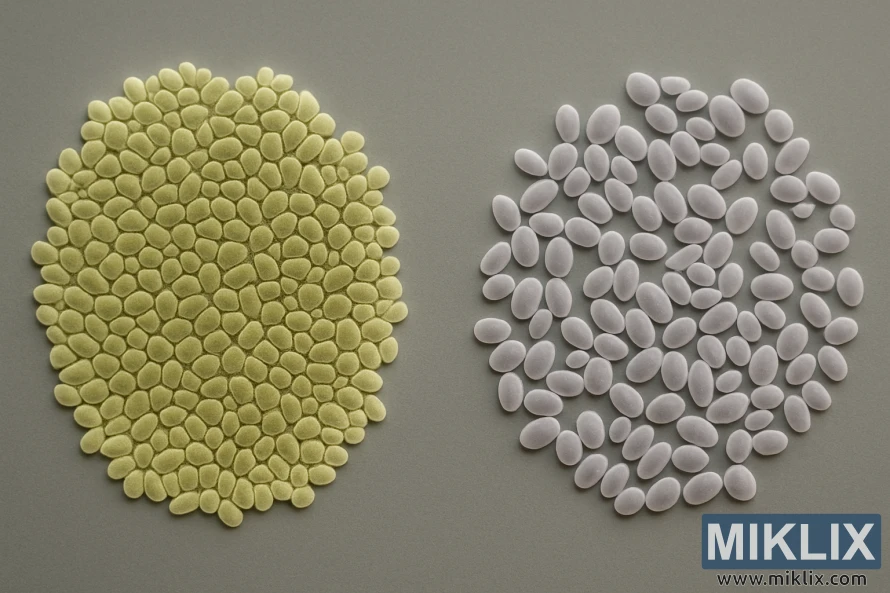Image: Saison Yeast Strain Comparison
Published: September 29, 2025 at 8:55:23 PM UTC
Photomicrograph showing two Saison yeast colonies side by side, highlighting differences in cell morphology, color, and growth patterns.
The image is a high-resolution, landscape-oriented photomicrograph-style depiction of two distinct yeast colonies presented side by side for comparison. The clean, neutral gray background sets a calm, controlled tone, eliminating visual distractions and ensuring that the viewer’s focus remains solely on the yeast samples. The lighting is soft and diffused, creating a clinical atmosphere reminiscent of studio photography for scientific purposes, yet with enough warmth to highlight texture and subtle variations.
On the left-hand side of the image, a tightly packed cluster of yeast cells forms a dense, contiguous structure. The cells are oval-shaped, flattened slightly along their edges where they press against one another, creating a tessellated pattern akin to cobblestones or scales. Their coloration leans toward a muted yellow-green, almost olive, suggesting a strain with a slightly darker or more pigmented morphology. The tightness of this cluster gives the impression of strong cohesion between cells, possibly reflective of flocculation tendencies—where yeast cells clump together during fermentation. The uniformity of size and shape within this colony underscores a sense of order and stability, though small variations in shading across individual cells create depth and realism. The texture is soft and velvety, almost plush, hinting at a natural surface quality visible only under magnification.
In contrast, the right-hand side of the image features a colony of yeast that is more dispersed and open. The cells are similar in overall oval shape but display a different coloration: a cool, pale lilac-gray tone that distinguishes them immediately from the yellow-green of the left colony. The looser arrangement makes the boundaries between individual cells clearer, allowing the viewer to appreciate their distinct forms without the crowded tessellation seen on the left. This spacing suggests a strain that flocculates less aggressively, remaining suspended longer in liquid before settling. The lighter coloration and gentler shading emphasize the individuality of each cell, while the scattered gaps between them highlight diversity in distribution and possibly differences in growth patterns. The right-hand cluster feels airy and more delicate compared to the dense solidity of the left-hand colony.
Together, the two sides form a striking visual comparison. Despite their shared classification as Saison yeast strains, their differences in morphology are immediately apparent. The left colony conveys strength, compactness, and weight, while the right colony expresses openness, clarity, and separation. The juxtaposition illustrates the subtle but important biological distinctions that yeast strains can exhibit—even within a style as specific as Saison.
The neutral gray background plays a critical role in the composition, ensuring that the colors and textures of the yeast colonies stand out vividly. No visual noise distracts from the observation; the background is intentionally understated to evoke the feeling of a microscope slide or controlled laboratory presentation. The lighting is expertly balanced—bright enough to reveal fine surface textures and subtle variations in tone, yet diffuse enough to avoid harsh reflections or glare. This careful illumination creates depth, making the colonies appear almost three-dimensional, as though the viewer could reach out and feel their texture.
From an educational standpoint, the image serves as a powerful tool. It demonstrates how yeast strains that perform similar functions in brewing—fermenting sugars, producing alcohol, generating esters and phenolics—can nonetheless differ in microscopic appearance, colony structure, and growth characteristics. This visual comparison could be used in a brewing science lecture, a textbook, or a technical presentation to highlight how strain selection impacts not just fermentation behavior but also yeast physiology.
Aesthetically, the image balances scientific rigor with visual engagement. The symmetry of the side-by-side layout appeals to the eye, while the color contrast between olive-yellow and lilac-gray provides immediate differentiation. The orderly repetition of cell shapes creates a rhythmic pattern that is both analytical and artistic. The overall mood is one of quiet observation—an invitation to pause, study, and appreciate the intricate forms of these microscopic organisms that play such a central role in the ancient craft of brewing.
The image is related to: Fermenting Beer with White Labs WLP590 French Saison Ale Yeast

